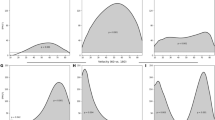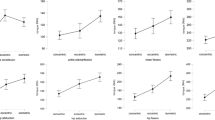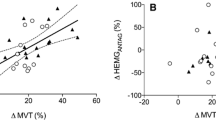Abstract
Purpose
There are suggestions that isometric resistance training (RT) produces highly angle-specific changes in strength with the greatest changes at the training angle, but these effects remain controversial with limited rigorous evidence, and the possible underpinning physiological mechanism(s) remain opaque. This study investigated the extent of angle-specific changes in strength and neuromuscular activation after RT in comparison to a control group.
Methods
A RT group (n = 13) performed 14 isometric RT sessions at a knee-joint angle of 65° (0° is anatomical position) over a 4-week period, whilst a control group (CON, n = 9) maintained their habitual activity. Pre- and post-test sessions involved voluntary and evoked isometric knee extension contractions at five knee-joint angles (35°, 50°, 65°, 80° and 95°), while electromyography was recorded.
Results
RT group increased maximum voluntary torque (MVT) at the training angle (65°; + 12%) as well as 80° (+ 7%), 50° (+ 11%) and 35° (+ 5%). Joint-angle specificity was demonstrated within the RT group (MVT increased more at some angles vs. others), and also by more rigorous between-group comparisons (i.e., larger improvements after RT vs. CON at some angles than others). For the RT group, normalized EMG increased at three of the same joint angles as strength, but not for CON. Importantly, however, neither within- or between-group analyses provided evidence of joint angle-specific changes in activation.
Conclusion
In conclusion, this study provides robust evidence for joint angle-specific strength gains after isometric RT, with weaker evidence that changes in neuromuscular activation may contribute to these adaptations.




Similar content being viewed by others

Abbreviations
- CON:
-
Control group
- CVW :
-
Within-participant coefficient of variation
- ECT:
-
Explosive contraction training
- EMG:
-
Electromyography
- EVC:
-
Explosive voluntary contraction
- M MAX :
-
Supramaximal muscle compound action potential
- M MAX P–P:
-
MMAX peak-to-peak amplitude
- MVC:
-
Maximum voluntary contraction
- MVT:
-
Maximum voluntary torque
- Octet PT:
-
Octet peak torque
- Octet T 50 :
-
Octet torque measure at 50 ms after torque onset
- QEMG0–50 :
-
Quadriceps femoris EMG epoch between 0 and 50 ms after EMG onset
- QEMG0–100 :
-
Quadriceps femoris EMG epoch between 0 and 100 ms after EMG onset
- QEMG0–150 :
-
Quadriceps femoris EMG epoch between 0 and 150 ms after EMG onset
- QEMGMVT :
-
Quadriceps femoris EMG at maximum voluntary torque
- RF:
-
Rectus femoris
- RT:
-
Resistance training
- SCT:
-
Sustained contraction training
- T 50 :
-
Explosive torque at 50 ms after torque onset
- T 100 :
-
Explosive torque at 100 ms after torque onset
- T 150 :
-
Explosive torque at 150 ms after torque onset
- Twitch PT:
-
Twitch peak torque
- Twitch T 50 :
-
Twitch torque measure at 50 ms after torque onset
- VL:
-
Vastus lateralis
- VM:
-
Vastus medialis
References
Alegre LM, Ferri-Morales A, Rodriguez-Casares R, Aguado X (2014) Effects of isometric training on the knee extensor moment–angle relationship and vastus lateralis muscle architecture. Eur J Appl Physiol 114:2437–2446. https://doi.org/10.1007/s00421-014-2967-x
Balshaw TG, Massey GJ, Maden-Wilkinson TM et al (2016) Training-specific functional, neural, and hypertrophic adaptations to explosive- vs. sustained-contraction strength training. J Appl Physiol 120:1364–1373. https://doi.org/10.1152/japplphysiol.00091.2016
Balshaw TG, Fry A, Maden-Wilkinson TM et al (2017) Reliability of quadriceps surface electromyography measurements is improved by two vs. single site recordings. Eur J Appl Physiol 117:1085–1094. https://doi.org/10.1007/s00421-017-3595-z
Behan FP, Pain MTG, Folland JP (2018) Explosive voluntary torque is related to whole-body response to unexpected perturbations. J Biomech 81:86–92. https://doi.org/10.1016/j.jbiomech.2018.09.016
Buckthorpe MW, Hannah R, Pain TG, Folland JP (2012) Reliability of neuromuscular measurements during explosive isometric contractions, with special reference to electromyography normalization techniques. Muscle Nerve 46:566–576. https://doi.org/10.1002/mus.23322
Buckthorpe M, Erskine RM, Fletcher G, Folland JP (2014) Task-specific neural adaptations to isoinertial resistance training. Scand J Med Sci Sports. https://doi.org/10.1111/sms.12292
Chye L, Nosaka K, Murray L et al (2010) Corticomotor excitability of wrist flexor and extensor muscles during active and passive movement. Hum Mov Sci 29:494–501. https://doi.org/10.1016/j.humov.2010.03.003
Cohen J (1988) Statistical power analysis for the behavioral sciences, 2nd edn, vol 567. Academic Press, Cambridge, MA
de Ruiter CJ, Kooistra RD, Paalman MI, de Haan A (2004) Initial phase of maximal voluntary and electrically stimulated knee extension torque development at different knee angles. J Appl Physiol 97:1693–1701
de Ruiter CJ, Hutter V, Icke C et al (2012) The effects of imagery training on fast isometric knee extensor torque development. J Sports Sci 30:166–174. https://doi.org/10.1080/02640414.2011.627369
Del Vecchio A, Casolo A, Negro F et al (2019) The increase in muscle force after 4 weeks of strength training is mediated by adaptations in motor unit recruitment and rate coding. J Physiol. https://doi.org/10.1113/JP277250
Erskine RM, Fletcher G, Folland JP (2014) The contribution of muscle hypertrophy to strength changes following resistance training. Eur J Appl Physiol 114:1239–1249. https://doi.org/10.1007/s00421-014-2855-4
Evangelidis PE, Massey GJ, Ferguson RA et al (2017) The functional significance of hamstrings composition: is it really a “fast” muscle group? Scand J Med Sci Sports 27:1181–1189. https://doi.org/10.1111/sms.12786
Folland JP, Williams AG (2007) The adaptations to strength training. Sport Med 37:145–168. https://doi.org/10.2165/00007256-200737020-00004
Gabriel DA, Kamen G, Frost G (2006) Neural adaptations to resistive exercise. Sport Med 36:133–149. https://doi.org/10.2165/00007256-200636020-00004
Gardner GW (1963) Specificity of strength changes of the exercised and nonexercised limb following isometric training. Res Q Am Assoc Health Phys Educ Recreat 34:98–101. https://doi.org/10.1080/10671188.1963.10613225
Hannah R, Minshull C, Buckthorpe MW, Folland JP (2012) Explosive neuromuscular performance of males versus females. Exp Physiol 97:618–629. https://doi.org/10.1113/expphysiol.2011.063420
Izquierdo M, Aguado X, Gonzalez R et al (1999) Maximal and explosive force production capacity and balance performance in men of different ages. Eur J Appl Physiol Occup Physiol 79:260–267. https://doi.org/10.1007/s004210050504
Johansson H, Sjölander P, Sojka P (1991) A sensory role for the cruciate ligaments. Clin Orthop Relat Res 268:161–178
Kinser PA, Robins JL (2013) Control group design: enhancing rigor in research of mind-body therapies for depression. Evid Based Complement Altern Med 2013:1–10. https://doi.org/10.1155/2013/140467
Kitai TA, Sale DG (1989) Specificity of joint angle in isometric training. Eur J Appl Physiol Occup Physiol 58:744–748
Kubo K, Ohgo K, Takeishi R et al (2006) Effects of isometric training at different knee angles on the muscle-tendon complex in vivo. Scand J Med Sci Sport 16:159–167. https://doi.org/10.1111/j.1600-0838.2005.00450.x
Lanza MB, Balshaw TG, Folland JP (2017) Do changes in neuromuscular activation contribute to the knee extensor angle–torque relationship? Exp Physiol 102:962–973. https://doi.org/10.1113/EP086343
Lanza MB, Balshaw TG, Massey GJ, Folland JP (2018) Does normalization of voluntary EMG amplitude to MMAX account for the influence of electrode location and adiposity? Scand J Med Sci Sports 28:2558–2566. https://doi.org/10.1111/sms.13270
Lanza MB, Balshaw TG, Folland JP (2019) Explosive strength: effect of knee-joint angle on functional, neural, and intrinsic contractile properties. Eur J Appl Physiol 119:1735–1746. https://doi.org/10.1007/s00421-019-04163-0
Lum D, Barbosa TM (2019) Brief review: effects of isometric strength training on strength and dynamic performance. Int J Sports Med 40:363–375. https://doi.org/10.1055/a-0863-4539
Maeo S, Shan X, Otsuka S et al (2018) Neuromuscular adaptations to work-matched maximal eccentric versus concentric training. Med Sci Sport Exerc 50:1629–1640. https://doi.org/10.1249/MSS.0000000000001611
Maffiuletti NA, Aagaard P, Blazevich AJ et al (2016) Rate of force development: physiological and methodological considerations. Eur J Appl Physiol 116:1091–1116. https://doi.org/10.1007/s00421-016-3346-6
Mitsuhashi K, Seki K, Akamatsu C, Handa Y (2007) Modulation of excitability in the cerebral cortex projecting to upper extremity muscles by rotational positioning of the forearm. Tohoku J Exp Med 212:221–228. https://doi.org/10.1620/tjem.212.221
Morganti CM, Nelson ME, Fiatarone MA et al (1995) Strength improvements with 1 yr of progressive resistance training in older women. Med Sci Sports Exerc 27:906–912
Noorkoiv M, Nosaka K, Blazevich AJ (2014) Neuromuscular adaptations associated with knee joint angle-specific force change. Med Sci Sports Exerc 46:1525–1537. https://doi.org/10.1249/MSS.0000000000000269
Paasuke M, Ereline J, Gapeyeva H (2001) Knee extension strength and vertical jumping performance in nordic combined athletes. J Sports Med Phys Fit 41:354–361
Pijnappels M, van der Burg JCE, Reeves ND, van Dieën JH (2008) Identification of elderly fallers by muscle strength measures. Eur J Appl Physiol 102:585–592. https://doi.org/10.1007/s00421-007-0613-6
Sale DG (1988) Neural adaptation to resistance training. Med Sci Sports Exerc 20:S135–S145
Seynnes OR, de Boer M, Narici MV (2007) Early skeletal muscle hypertrophy and architectural changes in response to high-intensity resistance training. J Appl Physiol 102:368–373. https://doi.org/10.1152/japplphysiol.00789.2006
Thepaut-Mathieu C, Van Hoecke J, Maton B (1988) Myoelectrical and mechanical changes linked to length specificity during isometric training. J Appl Physiol 64:1500–1505
Tillin NA, Folland JP (2014) Maximal and explosive strength training elicit distinct neuromuscular adaptations, specific to the training stimulus. Eur J Appl Physiol 114:365–374. https://doi.org/10.1007/s00421-013-2781-x
Tillin NA, Pain MTG, Folland JP (2012) Short-term training for explosive strength causes neural and mechanical adaptations. Exp Physiol 97:630–641. https://doi.org/10.1113/expphysiol.2011.063040
Tillin NA, Pain MTG, Folland J (2013a) Explosive force production during isometric squats correlates with athletic performance in rugby union players. J Sports Sci 31:66–76. https://doi.org/10.1080/02640414.2012.720704
Tillin NA, Pain MTG, Folland JP (2013b) Identification of contraction onset during explosive contractions. Response to Thompson et al. “Consistency of rapid muscle force characteristics: Influence of muscle contraction onset detection methodology” [J Electromyogr Kinesiol 2012;22(6):893–900]. J Electromyogr Kinesiol 23:991–994. https://doi.org/10.1016/j.jelekin.2013.04.015
Ullrich B, Kleinöder H, Brüggemann GP (2009) Moment–angle relations after specific exercise. Int J Sports Med. https://doi.org/10.1055/s-0028-1104589
Weir JP, Housh TJ, Weir LL, Johnson GO (1995) Effects of unilateral isometric strength training on joint angle specificity and cross-training. Eur J Appl Physiol Occup Physiol 70:337–343. https://doi.org/10.1007/BF00865031
Author information
Authors and Affiliations
Contributions
MBL, TGB, and JPF contributed to the design and implementation of the research to the analysis of the results and to the writing of the manuscript. All authors read and approved the manuscript.
Corresponding author
Ethics declarations
Conflict of interest
All authors declare that they have no conflicts of interest.
Additional information
Communicated by Olivier Seynnes.
Publisher's Note
Springer Nature remains neutral with regard to jurisdictional claims in published maps and institutional affiliations.
Rights and permissions
About this article
Cite this article
Lanza, M.B., Balshaw, T.G. & Folland, J.P. Is the joint-angle specificity of isometric resistance training real? And if so, does it have a neural basis? . Eur J Appl Physiol 119, 2465–2476 (2019). https://doi.org/10.1007/s00421-019-04229-z
Received:
Accepted:
Published:
Issue Date:
DOI: https://doi.org/10.1007/s00421-019-04229-z



